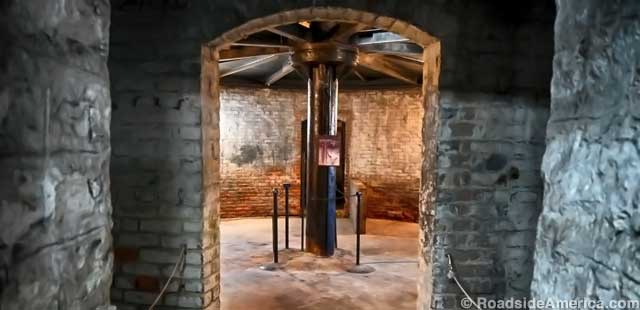
Despite the ominous appearance of its underbelly, the Rotary Jail was viewed as humane for its time.
Rotary Jail That Rotates
Crawfordsville, Indiana
The prison-of-the-future opened in Crawfordsville, Indiana, on June 17, 1882. Called the Rotary Jail, it was the brainstorm of Indiana architect William H. Brown and a couple of local ironmongers. Imagine an immense, very slow salad spinner, and you'll have an idea of how it works.
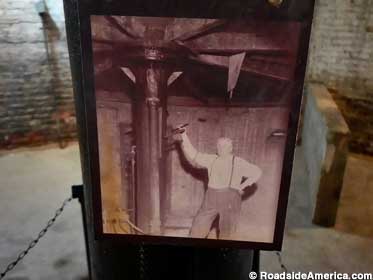
Old photo of a Rotary Jail worker about to mass-flush all of its toilets.
The jail is basically a big, indoor metal drum, sectioned into cells like slices of a pie. In the center if the drum is a shaft, and surrounding the drum is a circular cage with only one door. A jailer turns a crank to spin the drum on the shaft until a pie-slice cell faces the door. Then the door is unlocked, a prisoner is put in or taken out, and the drum is cranked to spin it to another cell.
"The idea behind a Rotary Jail is that you didn't have to have as many guards," said Brittany Turpin, executive director of the Rotary Jail Museum. Ideally, one guy with a hand crank and a gun could handle a whole jail full of prisoners. "It was also the idea," said Brittany, "that inmates should be treated more humanely." Prisoners in the Rotary Jail had it good for the 19th century: they slept on straw mattresses, had windows and fresh air, three meals a day, laundry service, and visits from a doctor. "They had toilets inside their cells at a time when most people didn't have toilets inside their houses," said Brittany. In the early years, she said, hungry or homeless people in Montgomery County would sometimes commit minor crimes just to spend a night in the spinning prison.

The circular rotating part of the jail is concealed within a square-cornered building.
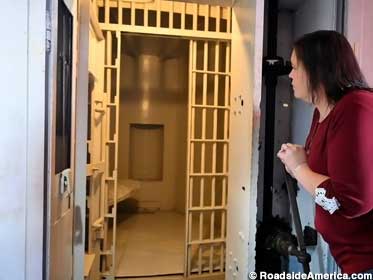
Museum director Brittany Turpin cranks around another jail cell.
The Crawfordsville jail was "a unique and expensive experiment in penology," according to a museum display, and within ten years it had inspired the creation of 17 similar rotary jails in 14 states, stretching from New Hampshire to Utah. Three of them still stand, but none is functioning as a jail. Crawfordsville's is the only one that still rotates.
So why aren't all of our convicts still spinning on prison turntables? There were problems. One was that the big drum with its metal cell walls and floors turned into an oven in July and a freezer in January. "During the first five winters inmates were getting frostbite," said Brittany. Another problem was fire; if one broke out, the only way to evacuate the prisoners was to crank them out one by one, which meant that many might die awaiting their turn. A third problem was drunk prisoners. Brittany said that half of Crawfordsville's inmates were there because they were drunk, and they would sometimes pass out with their arms or legs hanging through the bars. When the jail turned, those body parts met obstructions, resulting in mangled, limbless drunks.
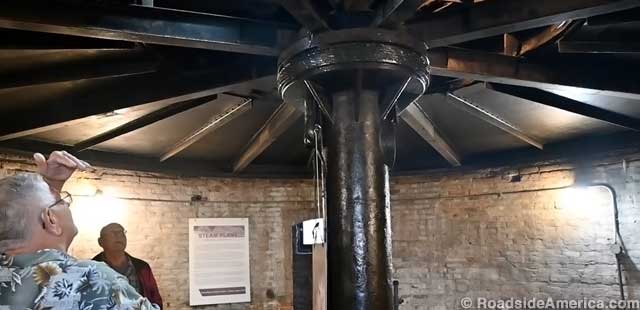
Visitors seem unconcerned that 27 tons of iron and steel are balanced above their heads.
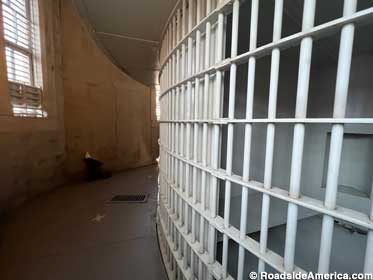
The Rotary Jail had a nasty reputation for severing outstretched arms and legs.
"We had an inmate with a wooden leg who would fit it between the bars when the jail would rotate," said Brittany, "and then the county would have to buy him another leg. After that happened a few times they began to confiscate it when he would come in."
The Crawfordsville Rotary Jail spun prisoners for over 50 years before the mechanism was disabled in the 1930s. It opened to the public as a museum in 1975, and after considerable effort the jail was made to spin again.
Visitors to the Rotary Jail can see an exhibit about its two known executions, including a ticket to John Henning's hanging in 1886 ("prices ranged from two to five dollars") and a description of John Coffee's bungled execution in 1885, where the rope broke twice and he was eventually strangled to death (The museum displays the bolt that held the noose). But the main reason to come to the Rotary Jail is to watch it rotate. Tourists sometimes find it disappointing (but understandable for insurance purposes) that they aren't allowed to take a spin in the jail or to rotate it -- a sign warns "No Rides" and that anyone who tries to turn the crank will be kicked out -- so setting the jail in motion is left to the museum staff.
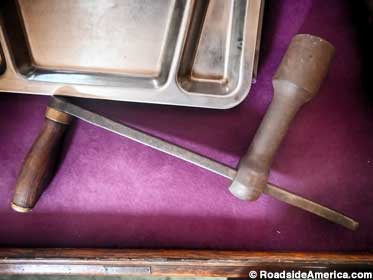
Cranking the Rotary Jail was not for wimps.
"You have to pay attention to the upswing," Brittany said of the crank. "If you're not careful the bar can come up and hit you in the face." The drum is made of 27 tons of iron and steel, and the settling of the ground beneath the building has made cranking the jail tougher than it was in 1882. Brittany compared it to pushing a heavy piece of furniture up a flight of stairs, or a pickup truck that had run out of gas.
Part of the Rotary Jail Museum tour leads to the basement, where visitors learn that the shaft supporting the jail doubled as its sewer pipe. "I'd say 25 percent of the questions we get at the jail are, 'How did the toilets work?'" said Brittany. The answer involves a rainwater cistern on the roof, and an inventive procedure of mass flushing.
The caretakers of America's only operational Rotary Jail work diligently to keep it in motion. Even in winter, when the building is closed to the public, someone has to come in several times a week to rotate the jail so that the gears won't stick. And a local engineering firm visits the building twice a year to inspect the mechanism and grease the bearings. "We're told by them that as long as we keep moving it regularly," said Brittany, "that it can keep turning for years to come, or forever."





